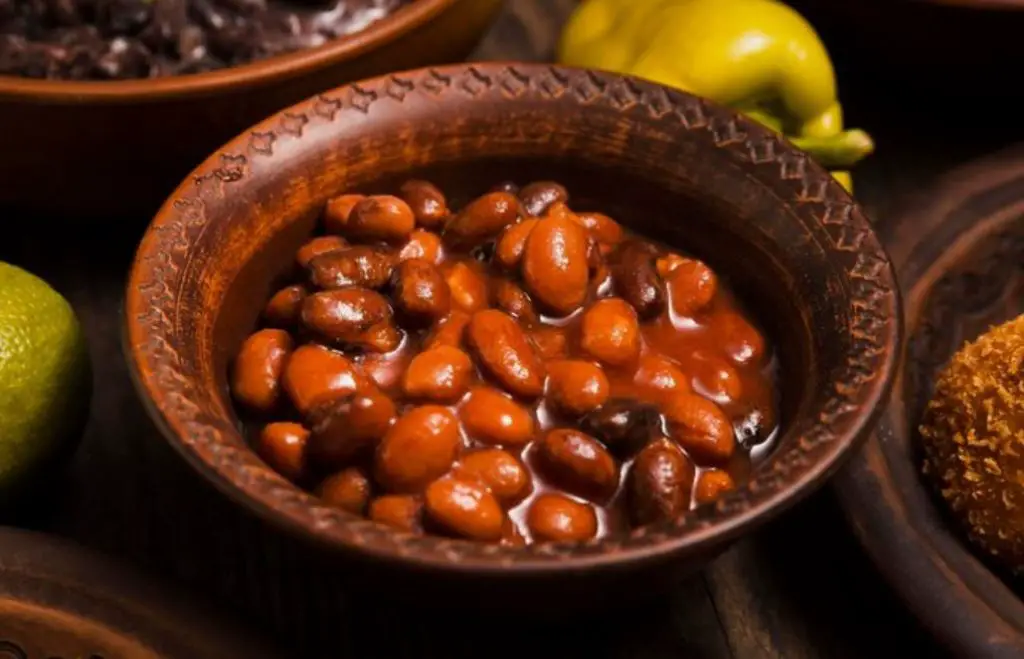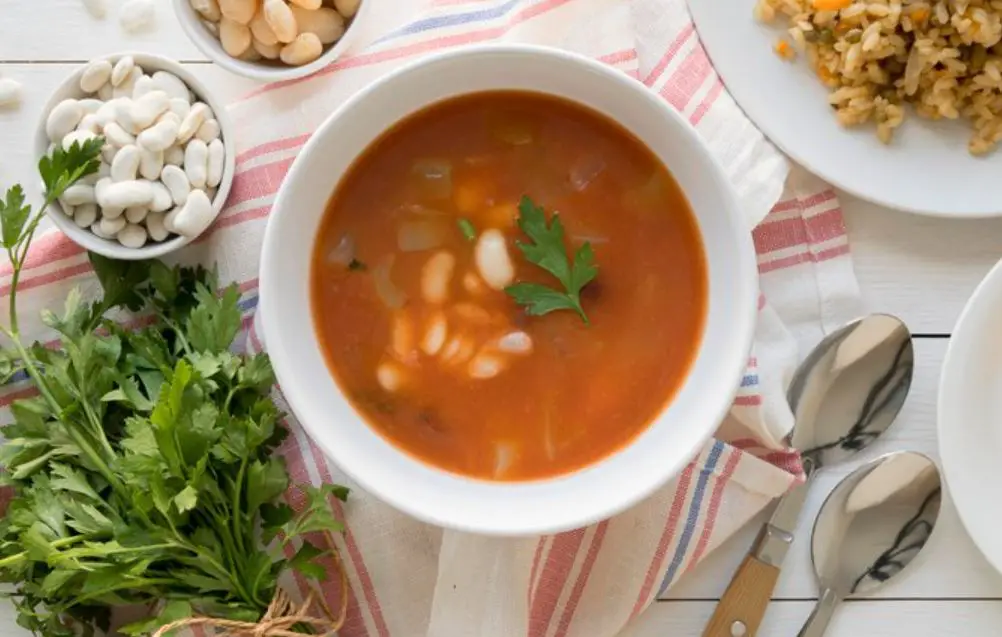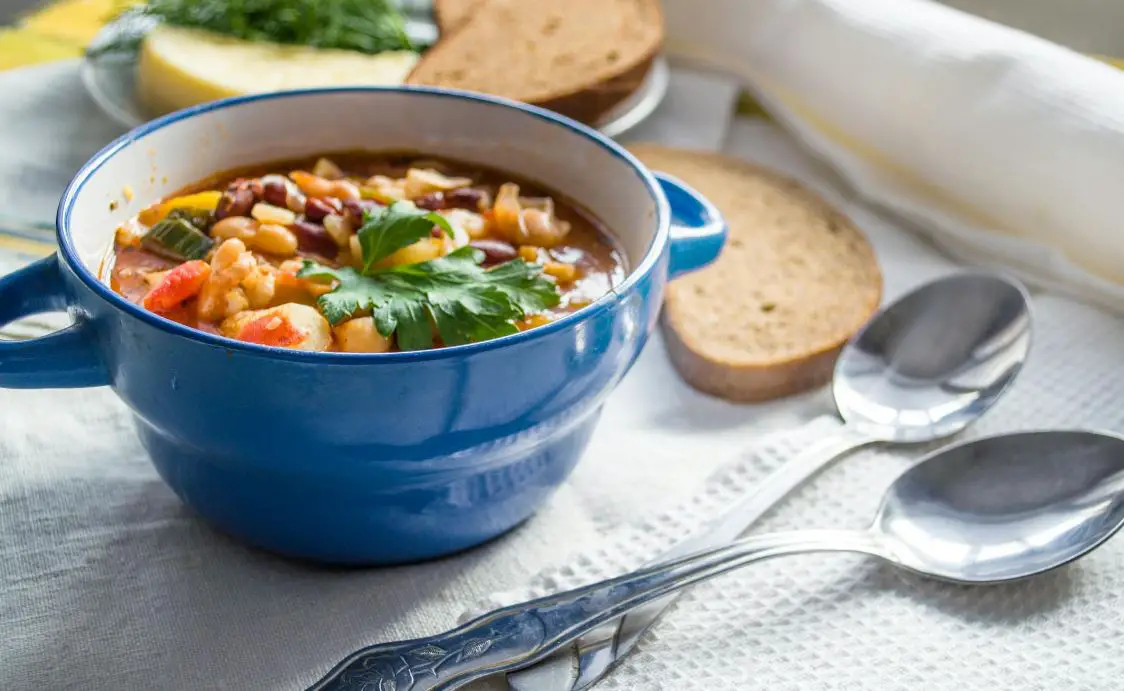Introduction to Portuguese Bean Soup
Portuguese cuisine, a rich tapestry of flavors and traditions, offers a unique culinary experience deeply rooted in history and cultural exchange. Among its diverse array of dishes, the Portuguese Bean Soup stands out as a quintessential representation of this vibrant culinary landscape. This soup, a harmonious blend of beans, vegetables, and meats, encapsulates the essence of Portuguese cooking, reflecting a legacy of both local ingredients and global influences.
A Comfort Food for All Seasons
Portuguese Bean Soup is more than just a dish; it’s a comfort food that transcends seasons, warming hearts during chilly winters and offering a nourishing repast in the summer. Its versatility and heartiness have made it a beloved staple in Portuguese households, a symbol of home-cooked warmth and familial bonds. Each spoonful of this rich, flavorful soup is a journey through the tastes and aromas of Portugal, a culinary hug that soothes and satisfies.
Historical Roots of Portuguese Bean Soup
The origins of Portuguese Bean Soup are as rich and complex as its flavors. This humble yet hearty dish is a testament to Portugal’s historical journey, influenced by various cultures and culinary practices.
Influences from Portuguese Colonies
Portugal’s age of exploration and colonization left an indelible mark on its cuisine, with the introduction of new ingredients and spices from far-flung lands. These global influences are evident in the Portuguese Bean Soup, which incorporates a variety of spices and flavors, reflecting the country’s historical maritime routes and colonial interactions.
Evolution Over the Centuries
Over the centuries, Portuguese Bean Soup has evolved, adapting to changes in society, economy, and culinary trends. From its simple beginnings to its current status as a beloved national dish, the soup has undergone numerous transformations, each iteration adding a new layer to its rich history. Today, it stands as a symbol of Portugal’s culinary resilience and adaptability, a dish that has withstood the test of time and continues to be cherished by generations.
Key Ingredients and Their Significance
Beans: The Heart of the Soup
Beans form the backbone of the Portuguese Bean Soup, serving as a source of rich flavor and hearty texture. In Portugal, the choice of beans varies, but each type brings its unique taste and nutritional value, making the soup not just delicious but also a wholesome meal. The beans absorb the flavors of the broth and other ingredients, creating a harmonious blend that is both satisfying and comforting.
The Role of Spices and Herbs
Spices and herbs play a pivotal role in defining the character of the Portuguese Bean Soup. The use of traditional spices like paprika, cumin, and bay leaves, along with fresh herbs such as parsley and coriander, imparts depth and complexity to the dish. These elements not only enhance the flavor but also pay homage to Portugal’s historical spice trade, adding layers of cultural significance to every bowl.
Variations Across Portugal and Beyond
Regional Twists on the Classic Recipe
Across Portugal, regional variations of the Bean Soup reflect local tastes and ingredient availability. In some areas, the soup is enriched with local sausages or seafood, while in others, different types of beans or vegetables are used. These regional adaptations showcase the diversity of Portuguese cuisine and the soup’s ability to adapt to different palates and ingredients.
Adaptations in the Global Diaspora
As Portuguese communities established themselves around the world, they brought their beloved Bean Soup with them, leading to new adaptations. In the global diaspora, the soup has been reinvented using locally available ingredients, resulting in a fascinating blend of traditional Portuguese flavors with international influences. These global variations not only keep the tradition alive but also introduce this quintessential Portuguese dish to a wider audience.
Key Ingredients and Their Significance
Beans: The Heart of the Soup
Beans are not just an ingredient in Portuguese Bean Soup; they are its very essence. Each bean, whether kidney, pinto, or lima, brings a unique texture and flavor, absorbing and melding the surrounding aromas. This ingredient transforms the soup into a hearty, nourishing meal, embodying the spirit of Portuguese cuisine.
The Role of Spices and Herbs
The spices and herbs in Portuguese Bean Soup do more than flavor; they tell a story. Ingredients like paprika, cumin, and bay leaves, along with fresh herbs such as parsley and coriander, are not random choices. They are culinary echoes of Portugal’s rich history in the spice trade, adding layers of depth and complexity to the soup.

Variations Across Portugal and Beyond
Regional Twists on the Classic Recipe
Across Portugal, the Bean Soup reflects the diversity of its regions. From the addition of local sausages in the north to the inclusion of fresh seafood along the coast, each variation honors the traditional recipe while showcasing regional flavors. This adaptability is a testament to the soup’s enduring popularity across the country.
Adaptations in the Global Diaspora
As Portuguese communities spread across the globe, they took their beloved Bean Soup with them. In new lands, the soup evolved, incorporating local ingredients and tastes. These adaptations highlight the soup’s versatility and its ability to resonate with a global audience, making it a cherished dish far beyond Portugal’s borders.
Step-by-Step Cooking Guide
Embark on a culinary journey with the Portuguese Bean Soup, a dish that promises both warmth and flavor in every spoonful.
Preparing the Ingredients
Start by selecting high-quality beans, soaking them overnight to ensure they cook evenly. Gather fresh vegetables onions, carrots, and potatoes chopping them into bite-sized pieces for a consistent texture. Choose your meats, like chorizo or ham, cutting them into similar sizes to harmonize with the vegetables. This initial preparation sets the stage for a soup that’s both flavorful and visually appealing.
The Art of Slow Cooking
The essence of Portuguese Bean Soup lies in its slow cooking process. Begin by sautéing onions and meats to unlock their flavors, then introduce the beans and vegetables. Cover them with a rich broth, letting the soup simmer gently. This slow cooking melds the diverse flavors into a harmonious and deeply satisfying dish, with each ingredient contributing to the overall symphony of tastes.
Nutritional Value and Health Benefits
Portuguese Bean Soup is a delightful blend of taste and health, offering a nutritious meal in every bowl.
A Wholesome Meal
Rich in proteins from beans and meats, and packed with vitamins and minerals from the vegetables, this soup is a nutritional powerhouse. The high fiber content from the beans aids in digestion, while the vegetables provide essential antioxidants, supporting overall health and well-being.
Dietary Considerations
This soup’s versatility allows it to be adapted for various dietary preferences. For vegetarians, omitting the meat and using vegetable broth keeps the essence of the dish intact. Those watching their sodium intake can choose low-sodium broth and fresh herbs for flavor. The soup can also be customized for gluten-free diets, ensuring it remains a healthy, inclusive option for all.
Pairing with Other Portuguese Dishes
Portuguese Bean Soup, with its rich and hearty flavors, pairs beautifully with other dishes from Portugal’s diverse culinary repertoire.
Complementary Flavors and Textures
To complement the soup’s robustness, consider pairing it with lighter, crisp dishes like a fresh Portuguese salad or grilled sardines. The acidity and freshness of these dishes balance the soup’s depth. For a heartier meal, serve it alongside a traditional Bacalhau à Brás (shredded salt cod with onions, fried potatoes, and scrambled eggs), creating a delightful contrast of textures and flavors.
Creating a Complete Portuguese Meal
For a truly immersive Portuguese dining experience, start with a light appetizer like Ameijoas à Bulhão Pato (clams in garlic sauce). Follow with the bean soup as the main course, and conclude with a sweet, creamy Pastel de Nata for dessert. This progression from light to hearty to sweet captures the essence of Portuguese dining, offering a well-rounded and satisfying meal.
Portuguese Bean Soup in Popular Culture
The Portuguese Bean Soup holds a special place in the cultural and social fabric of Portugal, often appearing in various forms of popular culture.
Featured in Literature and Film
This iconic soup has been featured in Portuguese literature and films, often symbolizing comfort, home, or the simplicity of rural life. It’s not uncommon to find scenes in Portuguese novels or movies where characters gather around a steaming pot of bean soup, sharing stories and creating a sense of community and belonging.
A Symbol in Festivals and Celebrations
In Portugal, the Bean Soup is more than just a dish; it’s a part of celebrations and festivals. During popular gatherings like the Festa de São João in Porto or the Lisbon Feasts, the soup is often served, symbolizing hospitality and festivity. It’s a dish that brings people together, representing the warmth and generosity of the Portuguese spirit.
Expert Tips for the Perfect Portuguese Bean Soup
Secrets from Portuguese Chefs
Portuguese chefs often emphasize the importance of using fresh, high-quality ingredients for the best flavor. They recommend a slow and gentle simmering process to allow the flavors to develop fully. Another secret is the use of a smoked meat, like chorizo, which imparts a deep, rich flavor to the soup. Lastly, balancing the spices and herbs is crucial – a hint of paprika or a bay leaf can make a significant difference.
Common Mistakes to Avoid
One common mistake is rushing the cooking process. This soup needs time for the flavors to meld together. Overcooking the beans is another pitfall; they should be tender but not mushy. Additionally, be cautious with salt, especially if using store-bought broth or cured meats, which can already be quite salty.

Serving and Presentation Ideas
Traditional vs. Modern Plating
Traditionally, Portuguese Bean Soup is served in a simple, rustic manner, often in a deep bowl with a spoonful of rice. For a modern twist, serve it in a shallow bowl, highlighting the ingredients and colors, and pair it with a slice of artisan bread on the side. This contemporary presentation can elevate the dish’s visual appeal without losing its traditional essence.
Garnishing for Enhanced Flavor
Garnishing is not just about aesthetics; it also enhances the flavor. A sprinkle of freshly chopped parsley or coriander can add freshness to the dish. A drizzle of high-quality olive oil just before serving introduces a new layer of flavor. For a bit of acidity and brightness, consider a squeeze of lemon. These small touches can significantly elevate the overall dining experience.
Storing and Reheating Tips
Preserving Flavor and Texture
To maintain the soup’s flavor and texture, cool it down before storing. Refrigerate in airtight containers, which helps preserve its richness for up to 4 days. For freezing, use freezer-safe containers, leaving some space for expansion, and it can last up to 2-3 months. When reheating, gently warm it on the stove over low heat, adding a bit of water or broth if the soup has thickened.
Best Practices for Leftovers
Leftover Portuguese Bean Soup often tastes better as the flavors deepen. When reheating, avoid boiling, as this can break down the beans and vegetables, altering the texture. If frozen, thaw it in the refrigerator overnight before reheating. Always reheat only the portion you plan to consume, as repeated reheating can affect the taste and quality.
Portuguese Bean Soup for Special Diets
Vegetarian and Vegan Adaptations
For a vegetarian or vegan version, omit the meat and use vegetable broth. Enhance the flavor with smoked paprika to mimic the smokiness of traditional meats. You can also add more vegetables like spinach or kale for added nutrition and texture.
Gluten-Free and Low-Carb Options
For a gluten-free version, ensure that all processed ingredients like broth or canned beans are gluten-free. For a lower-carb option, reduce the number of beans and increase the proportion of low-carb vegetables like kale, spinach, or cauliflower. These adaptations allow those on special diets to enjoy the rich flavors of Portuguese Bean Soup without compromising their dietary needs.
Cooking Portuguese Bean Soup in Different Cookware
Traditional Pot vs. Modern Appliances
Cooking Portuguese Bean Soup in a traditional pot, like a terracotta or a heavy-bottomed pot, is the classic method, allowing for even heat distribution and a rich melding of flavors. Modern appliances like slow cookers or pressure cookers offer convenience and speed. A slow cooker can mimic the gentle simmering of traditional methods, while a pressure cooker significantly reduces cooking time, which can be a boon for busy cooks.
Impact on Flavor and Texture
The choice of cookware can influence the soup’s flavor and texture. Traditional pots often yield a deeper, more developed flavor profile due to the longer cooking time. In contrast, modern appliances might not provide the same depth of flavor but are excellent for achieving consistent texture, especially for the beans, and are more energy-efficient.
Portuguese Bean Soup and Health
Low-Fat and Low-Sodium Variations
For a healthier version of Portuguese Bean Soup, opt for low-fat meats or increase the proportion of vegetables. Using homemade broth or low-sodium store-bought versions can control the sodium content. Additionally, skimming off fat from the top of the soup once it’s cooked can reduce fat content without compromising the flavor.
Balancing Taste and Health
Creating a healthier version of this traditional soup doesn’t mean sacrificing taste. Herbs and spices can be used generously to add flavor without adding fat or sodium. Incorporating a variety of vegetables not only enhances the nutritional profile but also adds layers of flavor and texture. By making these adjustments, the soup remains a comforting and hearty dish while aligning with health-conscious cooking principles.
Portuguese Bean Soup Recipe
Hearty Portuguese Bean and Sausage Stew
Ingredients:
- 1 lb chorizo or Portuguese sausage, sliced
- 2 cups kidney beans, soaked overnight and drained
- 1 large onion, chopped
- 3 cloves garlic, minced
- 2 large potatoes, peeled and cubed
- 1 can (14.5 oz) diced tomatoes
- 4 cups chicken or vegetable broth
- 1 large carrot, sliced
- 1/2 head cabbage, chopped
- 1 teaspoon paprika
- Salt and pepper to taste
- 2 tablespoons olive oil
Directions:
- In a large pot, heat olive oil over medium heat. Add the sausage and cook until browned. Remove sausage and set aside.
- In the same pot, add onion and garlic, sautéing until the onion is translucent.
- Add the potatoes, carrots, and soaked beans to the pot. Stir in the diced tomatoes and chicken broth.
- Bring to a boil, then reduce heat to low and simmer for about 1 hour, or until beans are tender.
- Add the cabbage, cooked sausage, paprika, salt, and pepper. Simmer for another 15 minutes.
- Check seasoning and adjust if necessary. Serve hot.
Prep Time: 15 minutes | Cooking Time: 1 hour 15 minutes | Total Time: 1 hour 30 minutes
Kcal: 350 kcal | Servings: 6 servings

FAQs About Portuguese Bean Soup
Common Questions and Expert Answers
Can I use canned beans instead of dried beans?
Yes, canned beans are a convenient alternative. Just remember to rinse them to remove excess sodium and add them later in the cooking process since they’re already cooked.
How can I make the soup more flavorful?
Enhance the flavor by using a homemade broth, adding a piece of smoked meat, and adjusting the seasoning with herbs and spices. Slow cooking also helps intensify the flavors.
Is Portuguese Bean Soup suitable for freezing?
Absolutely. This soup freezes well. Just cool it completely before freezing and leave some space in the container for expansion.
Can I make this soup in a vegetarian or vegan version?
Yes, simply omit the meat and use vegetable broth. You can add more vegetables or a meat substitute for added texture.
How long does this soup last in the refrigerator?
Properly stored in an airtight container, the soup can last 3-4 days in the refrigerator.
Conclusion: The Enduring Appeal of Portuguese Bean Soup
Portuguese Bean Soup, with its rich flavors and hearty ingredients, is more than just a traditional dish; it’s a culinary emblem of Portugal’s history and culture. Its versatility in ingredients and adaptability to various cooking methods and dietary preferences only add to its enduring appeal. Whether served in a humble kitchen or as part of a festive celebration, this soup remains a beloved staple, warming hearts and bringing people together. Its ability to evolve while maintaining its core identity is a testament to its timeless charm and continued relevance in kitchens around the world.





